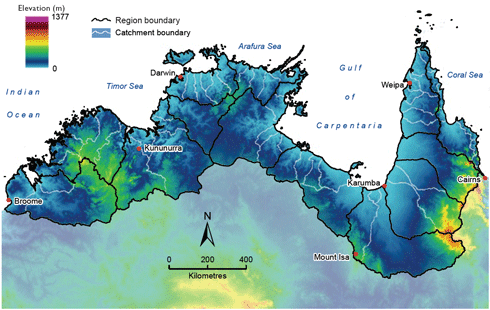
|
Published:
Low success from rainforest revegetation investment
A project to investigate the outcome of large government investments in community-based rainforest revegetation has found that only about half the area reported as revegetated was actually forested after six to 11 years. About half of this forested area was in poor or very poor condition – often due to a lack of monitoring or maintenance.

|
|
Kylie Freebody (centre) and colleagues review a forestry revegetation site. Credit: Griffith University
|
Project leader, Associate Professor Carla Catterall of Griffith University, says that despite the expenditure of tens of millions of dollars on replanting rainforest vegetation, and the dedicated enthusiasm of many community members, only about one per cent of previously cleared rainforest in tropical and subtropical Australia has been replanted with rainforest trees.
Dr Catterall and co-researchers Debra Harrison, Kylie Freebody and John Kanowski, funded by the Marine and Tropical Sciences Research Facility and Terrain NRM, followed up on a compilation of all available records of revegetation projects funded by the Natural Heritage Trust (NHT) in the Wet Tropics between 1997 and 2001. These projects covered a total area of 644 hectares at a total cost of more than $16 million (of which about $6 million was NHT funding).
Although some monitoring of project outcomes had occurred, the researchers noted that it often consisted of simply taking photos and in very few cases were surveys of the vegetation or fauna carried out.
‘Photos and visual observations can only indicate whether a small part of a planting is growing well at a particular point in time,’ says Dr Catterall.
Subsequent mapping and systematic recording of vegetation condition in a large number of six- to 11-year-old projects indicated that even where many trees had grown well, not all plantings had recruited a diverse rainforest understorey as intended.
‘Without the data that regular monitoring provides, the reasons for this poor development cannot be determined,’ says Dr Catterall. ‘In many cases the lack of monitoring was connected with the government’s policy of providing funding on a year-to-year basis for short-term revegetation works only.
‘Standard reporting processes covered the work done rather than the longer-term outcomes.’
She says appropriate targets to monitor during the establishment phase of reforested sites include survival and growth of planted trees, development of canopy closure, and the proportion of ground covered by grasses and weeds that might suppress the recruitment of rainforest plants.
In the later building and maintenance phases, appropriate monitoring targets include vegetation structure, floristic composition, the recruitment of plants and the use of reforested sites by wildlife.
Member of the project team and co-manager of the Tablelands Community Revegetation Unit, Kylie Freebody, says the project showed that monitoring needs to continue beyond the establishment phase.
‘We are predicting that you probably need to have annual monitoring of the planting for at least five years, and maybe 10 years, just to keep track of it,’ she says. ‘By monitoring, for example, cyclone damage which may have left big gaps in the canopy, you can see where maintenance is needed.’
This maintenance might involve, for example, intensively managing grasses and weeds with carefully applied herbicide for six to 12 months until the foliage of the undamaged trees grows back to block out the light.
Dr Catterall says funding agencies must recognise the need for continuous funding for independent regional management, monitoring and record-keeping of rainforest revegetation activities, especially given the long-term nature of the work and its increasing significance in the context of environmental offsets and carbon storage.
However, she says, typical reactions are often ‘we don’t have time to monitor, we don’t know what to do, we don’t have enough funding ...’
The finding that the NHT-funded projects had much poorer outcomes than indicated by standard reporting processes raised awareness of the need for a better-coordinated, regional-scale funding effort. Dr Catterall says that given the increased future role for carbon sequestration and offset markets, this will be crucial for credibility of reforestation in the Wet Tropics.
Largely as a result of this project, a regional monitoring and evaluation program involving collaboration between ecologists, revegetation practitioners and community groups, and the development of a regional-scale project database, has recently begun in the Wet Tropics region.
More information:
Kanowski J, Catterall CP and Harrison DA (2008) Monitoring the outcomes of reforestation for biodiversity conservation. In: Living in a Dynamic Tropical Forest Landscape. (Eds N Stork and S Turton) pp. 526–536. Wiley-Blackwell, Oxford.



